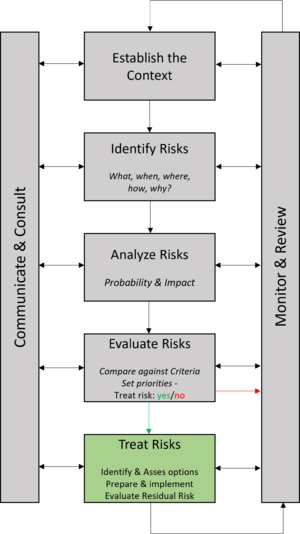Risk Treatment
Contents |
Abstract
Risk treatment as a method is an under category of risk management. It is an assessment of what to do, if the uncertainties identified during risk management occur. In other words it is a pre-defined action plan of how to handle potential problems in a project. The implementation of risk treatment before or early in a project increases the probability of general project success, by reducing the impact of unforeseen problems throughout the project.
Depending on the impact, probability and ease of handling the problem the risk treatment plan is often divided into four main categories: Avoidance, Reduction, Transfer, Acceptance.
Avoidance: the project manager avoids a potential risk, by not doing whatever the cause of the risk is.
Reduction: the project manager reduces the probability of a potential risk by taking mitigative actions.
Transfer: the project manager eliminates a risk by transferring it to a third-party. Examples of third-parties are insurance and outsourcing to other companies.
Acceptance: the project manager accepts the risk. Examples where this choice is viable include when a risk is impossible to eliminate or when it is more costly to prepare for/eliminate the risk than the effect it would have.
Each category has different application and limitations which lay the frame for dealing with the problem. As with much else in project management, and especially risk management, the nature of a problem can evolve before/during/after the project, which means that a detailed risk treatment plan can be a large factor in the success of project.
Big Idea
Risk management is a systematic process that assist decision-making within project management. It is an integral part of project success and should be integrated into the overall management structure. The process can be divided into five general steps excluding outlying support structures, the five steps progress in the following order: Establishing Context, Risk Identification, Risk Analysis, Risk Evaluation and Risk Treatment. Although, this is the general progression form, risk management is an agile tool, that requires the project manager to revisit earlier steps in the process throughout the project to mitigate potential risks created by the process itself and also unforeseen project risks. The five step process is visualized in Figure 1.(PMI 31000:2018)
Risk treatment is the vital final step, that helps the project manager efficiently and quickly handle the risks identified earlier in the risk management process. The objective in risk treatment is to have a detailed step-by-step action plan for as many imaginable future risks as possible.
Application
Limitations
Annotated Bibliograhpy
Project Management Institute, Inc. (PMI). (2019). Standard for Risk Management in Portfolios, Programs, and Projects. Project Management Institute, Inc. (PMI). Retrieved from https://app.knovel.com/hotlink/toc/id:kpSRMPPP01/standard-risk-management/standard-risk-management
DS/ISO 21502:2020
DS/ISO 31000:2018
Project Management Institute, Inc. (PMI). (2021). A Guide to the Project Management Body of Knowledge (PMBOK ® Guide) – 7th Edition and The Standard for Project Management. Project Management Institute, Inc. (PMI). Retrieved from https://app.knovel.com/hotlink/toc/id:kpSPMAGPMP/guide-project-management/guide-project-management
